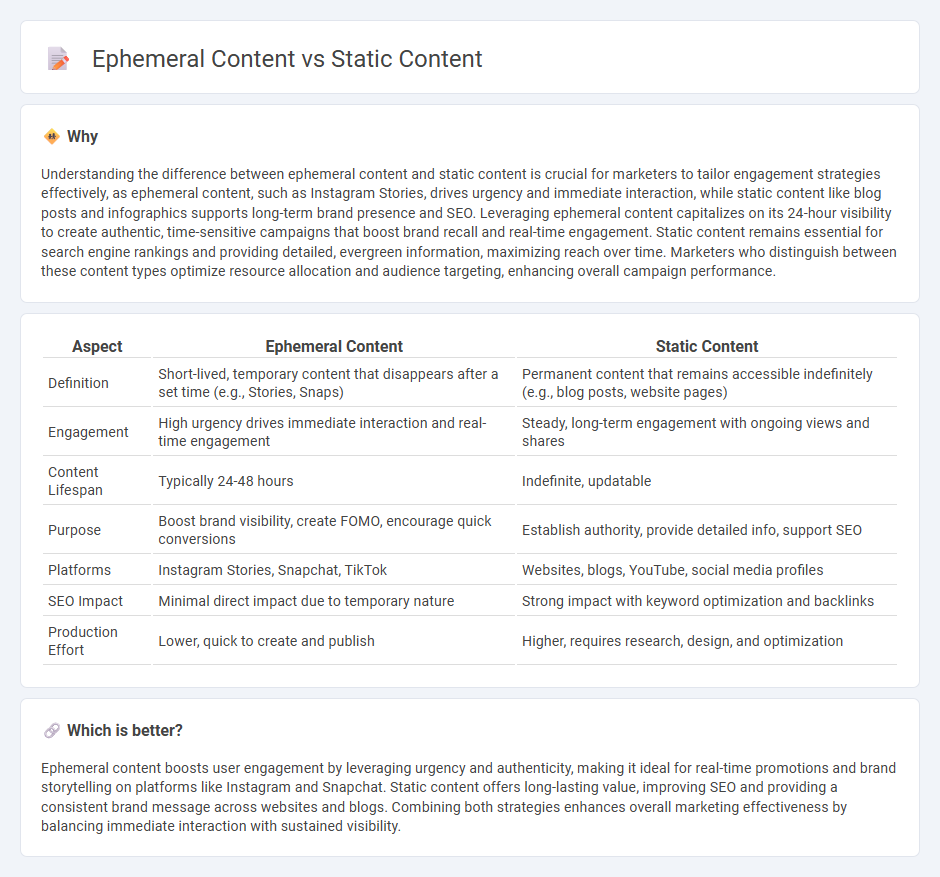
Ephemeral content, such as Instagram Stories and Snapchat Snaps, disappears after a short period, creating urgency and fostering authentic engagement with audiences. In contrast, static content like blog posts and social media images remains permanently accessible, offering lasting SEO benefits and consistent brand presence. Explore the strategic advantages of both content types to optimize your marketing campaigns.
Why it is important
Understanding the difference between ephemeral content and static content is crucial for marketers to tailor engagement strategies effectively, as ephemeral content, such as Instagram Stories, drives urgency and immediate interaction, while static content like blog posts and infographics supports long-term brand presence and SEO. Leveraging ephemeral content capitalizes on its 24-hour visibility to create authentic, time-sensitive campaigns that boost brand recall and real-time engagement. Static content remains essential for search engine rankings and providing detailed, evergreen information, maximizing reach over time. Marketers who distinguish between these content types optimize resource allocation and audience targeting, enhancing overall campaign performance.
Comparison Table
| Aspect | Ephemeral Content | Static Content |
|---|---|---|
| Definition | Short-lived, temporary content that disappears after a set time (e.g., Stories, Snaps) | Permanent content that remains accessible indefinitely (e.g., blog posts, website pages) |
| Engagement | High urgency drives immediate interaction and real-time engagement | Steady, long-term engagement with ongoing views and shares |
| Content Lifespan | Typically 24-48 hours | Indefinite, updatable |
| Purpose | Boost brand visibility, create FOMO, encourage quick conversions | Establish authority, provide detailed info, support SEO |
| Platforms | Instagram Stories, Snapchat, TikTok | Websites, blogs, YouTube, social media profiles |
| SEO Impact | Minimal direct impact due to temporary nature | Strong impact with keyword optimization and backlinks |
| Production Effort | Lower, quick to create and publish | Higher, requires research, design, and optimization |
Which is better?
Ephemeral content boosts user engagement by leveraging urgency and authenticity, making it ideal for real-time promotions and brand storytelling on platforms like Instagram and Snapchat. Static content offers long-lasting value, improving SEO and providing a consistent brand message across websites and blogs. Combining both strategies enhances overall marketing effectiveness by balancing immediate interaction with sustained visibility.
Connection
Ephemeral content and static content complement each other in marketing strategies by addressing different audience engagement needs; ephemeral content creates urgency and fosters real-time interaction through fleeting posts on platforms like Instagram Stories, while static content provides lasting value and detailed information via blogs or website pages. Marketers leverage ephemeral content to boost brand awareness and immediacy, driving traffic to comprehensive static content that supports deeper customer education and conversion. Integrating both formats enhances overall campaign effectiveness, balancing immediacy with longevity to maximize reach and consumer retention.
Key Terms
Permanence
Static content remains unchanged and accessible over time, providing a consistent user experience and long-term value for SEO due to its permanence. Ephemeral content, by contrast, disappears after a short period, creating urgency and real-time engagement but lacking lasting digital footprints. Explore how to balance permanence and immediacy to optimize your content strategy.
Engagement
Static content, such as blog posts and evergreen articles, provides consistent value over time but often sees limited immediate interaction due to its unchanging nature. Ephemeral content, including Instagram Stories and Snapchat posts, drives higher engagement rates by creating urgency and encouraging real-time user interaction. Explore strategies to harness both content types effectively to maximize your audience engagement.
Timeliness
Static content remains unchanged over time, providing consistent information such as product descriptions or company history, which supports long-term SEO strategies. Ephemeral content, including social media stories or live streams, emphasizes timeliness by creating urgency and real-time engagement that can drive immediate audience interaction. Explore how leveraging both content types can optimize your digital marketing impact.
Source and External Links
What is Static Content - IO River - Static content refers to files delivered to a user's browser exactly as stored on the server, including HTML, CSS, JavaScript, images, and PDFs, which do not change based on user interaction or behavior.
Static web page - Wikipedia - A static web page is delivered exactly as stored to all users, displaying the same information without changes, offering advantages like better security, faster performance, and fewer dependencies than dynamic pages.
What is Static Content? - Macrometa - Static content includes unchanging documents, style sheets, images, videos, and scripts served identically to all users, often cached via CDNs for faster load times and lower server load.
 dowidth.com
dowidth.com